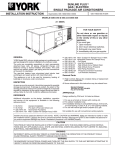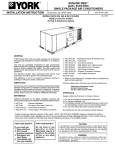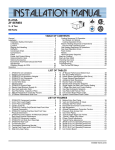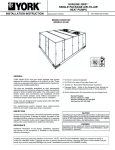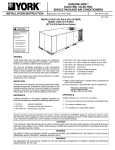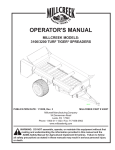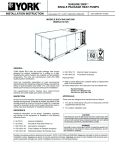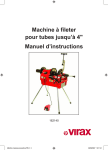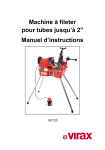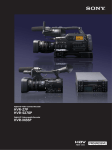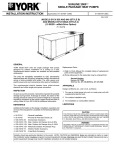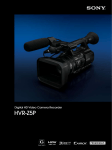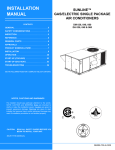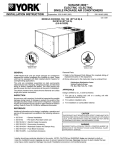Download York SUNLINE 2000 B5CH 036 Operating instructions
Transcript
®
INSTALLATION INSTRUCTION
SUNLINE 2000™
GAS / ELECTRIC
SINGLE PACKAGE AIR CONDITIONERS
Supersedes: 530.26-N2YI (1096)/035-14836-000
035-14836-001-A-0204
MODELS D5CG 036 & 048
MODEL D5CG 060 & 076 BELT DRIVE
(WORLD 50HZ)
FOR YOUR SAFETY
Do not store or use gasoline or
other flammable vapors or liquids
in the vicinity of this or any other
appliance.
If you smell gas:
1. Open windows
2. Don't touch electrical switches.
3. Extinguish any open flame.
4. Immediately call your gas supplier.
GENERAL
REFERENCE
YORK Model DCG units are single package air conditioners
with gas heat designed for outdoor installation on a rooftop or a
slab.
The units are completely assembled on rigid, permanently
attached base rails. All piping, refrigerant charge, and electrical
wiring is factory-installed and tested. The units require only
electric power, gas piping and duct connections at the point of
installation.
The gas-fired heaters have aluminized steel tubular heat
exchangers and spark ignition with intermittent pilot.
This appliance is not to be used for temporary heating of
buildings or structures under construction.
Additional information on the design, installation, operation and
service of this equipment is available in the following reference
forms:
INSPECTION
As soon as a unit is received, it should be inspected for possible
damage during transit. If damage is evident, the extent of the
damage should be noted on the carrier's freight bill. A separate
request for inspection by the carrier's agent should be made in
writing. Refer to Form 50.15-NM for additional information.
•
•
•
•
•
•
•
•
55.70-N1
55.70-N2
530.18-N1.2V
530.18-N1.4V
530.18-N1.6V
530.18-N1.8V
530.18-N8.2V
530.18-N8.4V
Renewal Parts:
-General Installation
-Pre-start & Post-start Check List
-Economizer Accessory
-Fixed Outdoor Air Damper Accessory
-Motorized Outdoor Air Damper Accy.
-Coil Guard
-High Altitude Accy. (Natural Gas)
-Gas Piping Accessory
• Refer to Parts Manual for complete listing of replacement
parts on this equipment.
All forms referenced in this instruction may be ordered from:
Standard Register
Telephone: (405)691-1126
Fax: (877)379-7920
Installer should pay particular attention to the words: NOTE, CAUTION and WARNING. Notes are intended to clarify or make the
installation easier. Cautions are given to prevent equipment damage. Warnings are given to alert installer that personal injury
and/or equipment damage may result if installation procedure is not handled properly.
CAUTION
THIS PRODUCT MUST BE INSTALLED IN STRICT COMPLIANCE WITH THE ENCLOSED INSTALLATION INSTRUCTIONS
AND ANY APPLICABLE LOCAL, STATE, AND NATIONAL CODES INCLUDING, BUT NOT LIMITED TO, BUILDING, ELECTRICAL, AND MECHANICAL CODES
WARNING
INCORRECT INSTALLATION MAY CREATE A CONDITION WHERE THE OPERATION OF THE PRODUCT COULD CAUSE
PERSONAL INJURY, PROPERTY DAMAGE AND/OR DEATH.
WARNING
DE-ENERGIZE THE ELECTRICAL POWER AND TURN OFF THE GAS SUPPLY TO THE UNIT BEFORE ATTEMPTING TO INSPECT, REPAIR OR PERFORM MAINTENANCE TO THE UNIT.
035-14836-001-A-0204
TABLE OF CONTENTS
MAINTENANCE & TROUBLESHOOTING
General................................................................................1
Inspection ............................................................................1
Reference ............................................................................1
Nomenclature ......................................................................2
Normal Maintenance .........................................................18
Cleaning Flue Passages and Heating Elements ...............18
Troubleshooting.................................................................19
INSTALLATION
TABLES
Limitations ...........................................................................3
Location ...............................................................................3
Rigging and Handling ..........................................................3
Clearances ..........................................................................3
Ductwork .............................................................................3
Filters...................................................................................4
Condensate Drain ...............................................................4
Service Access ....................................................................4
Thermostat ..........................................................................4
Power and Control Wiring ...................................................4
Blower Speed Selection ......................................................4
Compressors .......................................................................4
Combustion Discharge ........................................................4
Disconnect Switch Bracket For Optional Belt-Drive ............5
Gas Piping ...........................................................................6
Gas Connection...................................................................6
Vent and Combustion Air Hoods .........................................7
Optional Economizer Rain Hood .........................................8
No.
1
2
3
4
5
6
7
8
9
10
11
12
Description
Page
Unit Application Data..................................
3
Gas Heat Application Data.........................
5
Pipe Sizing ................................................
6
Physical Data .............................................
9
Electrical Data (Basic Unit) ........................
9
Motor & Drive Data-Belt-Drive Blower........
9
Accessory Static Resistances ....................
9
Supply Air Blower Perf. 3 & 4 Ton Belt-Drive 10
Supply Air Blower Perf. 5 & 6 Ton Belt-Drive 11
Limit Control Setting................................... 15
Belt Drive Supply Air Motor Pulley Adj. ...... 16
Gas Rate - Cubic Feet Per Hour ................ 17
No.
1
2
3
4
5
6
7
8
9
10
11
12
13
14
15
Description
Page
Center of Gravity ........................................
3
Recommended Drain Piping ......................
4
Typical Field Wiring ....................................
5
External Supply Connection.......................
6
Bottom Supply Connection.........................
6
Vent and Combustion Air Hoods ................
7
Economizer Rain Hood Assembly..............
7
Enthalpy Setpoint Adjustment ....................
8
Dimensions and Clearances ...................... 13
Gas Valve Piping........................................ 14
Gas Valves ................................................. 15
Proper Flame Adjustment .......................... 16
Typical Flame Appearance......................... 16
Belt Adjustment .......................................... 16
Press. Drop versus Supply Air CFM .......... 17
FIGURES
OPERATION
Cooling System .................................................................14
Preliminary Operation Cooling ..........................................14
Cooling Sequence of Operation ........................................14
Safty Controls (Cooling) ....................................................14
Heating Sequence of Operation ........................................14
Safety Controls (Heating) ..................................................15
Heat Anticipator Setpoints .................................................15
Pre-Start Check List ..........................................................15
START-UP
Operating Instructions .......................................................15
Post-Start Check List (Gas)...............................................15
Manifold Gas Pressure Adjustment ...................................15
Pilot Checkout ...................................................................16
Burner Instructions ............................................................16
Burner Air Shutter Adjustment...........................................16
Supply Air Blower and Temperature Rise Adjustment.......16
Checking Gas Input ...........................................................17
Secure Owner's Approval..................................................17
NOMENCLATURE
D
5
C
G
0
3
6
N
0
4
0
5
PRODUCT CATEGORY
D = Single Package Air Conditioner
0
VOLTAGE CODE
50 = 380/415-3-50
PRODUCT GENERATION
NOMINAL GAS HEATING
OUTPUT CAPACITY
5 = 5th Generation
040 = 11.7kW (40 MBH)
060 = 17.6kW (60 MBH)
079 = 23.1kW (79 MBH)
PRODUCT IDENTIFIER
CG = Gas/Electric
2
NOMINAL COOLING
CAPACITY
036 = 10.5kW (36 MBH)
048 = 14.0kW (48 MBH)
060 = 17.6kW (60 MBH)
076 = 22.2kW (76 MBH)
FACTORY INSTALLED
HEAT
N = Gas Heat Installed
Unitary Products Group
035-14836-001-A-0204
INSTALLATION
LIMITATIONS
RIGGING AND HANDLING
These units must be installed in accordance with applicable
national and local safety codes.
Exercise care when moving the unit. Do not remove any
packaging until the unit is near the place of installation. Rig the
unit by attaching chain or cable slings to the lifting holes
provided in the base rails. Spreaders, whose length exceeds
the largest dimension across the unit, MUST be used across
the top of the unit.
Refer to Table 1 for Unit Application Data and to Table 2 for Gas
Heat Application Data.
If components are to be added to a unit to meet local codes, they
are to be installed at the dealer's and / or the customer's expense.
TABLE 1 - UNIT APPLICATION DATA
UNIT SIZE
036
048
Voltage Variation 380/415Min. / Max.
3-50
Supply Air m3/s/CFM,
Nom.
060
076
342 / 457
0.57/1200 0.75/1600 0.94/2000 1.13/2400
Wet Bulb Temperature of Air on
Evaporator Coil,
Min. / Max.
°C
14 / 22
14 / 22
14 / 22
14 / 22
°F
57 / 72
57 / 72
57 / 72
57 / 72
Dry Bulb Temperature of Air on
Condenser Coil,
Min./ Max.
°C
7 / 52
7 / 52
7 / 52
7 / 52
°F
45 / 125 45 / 125 45 / 125 45 / 125
LOCATION
Use the following guidelines to select a suitable location for
these units.
BEFORE LIFTING A UNIT, MAKE SURE THAT ITS WEIGHT
IS DISTRIBUTED EQUALLY ON THE CABLES SO THAT IT
WILL LIFT EVENLY.
Units may also be moved or lifted with a forklift. Slotted
openings in the base rails are provided for this purpose.
LENGTH OF FORKS MUST BE A MINIMUM OF 1067 mm
(42 in.).
Remove the nesting brackets from the four corners on top of
the unit. All screws that are removed when taking these
brackets off must be replaced on the unit.
CAUTION: An adhesive backed label is provided over the outside of the combustion air inlet opening to prevent
moisture from entering the unit which could cause
damage to electrical components. Allow this closure label to remain in place until the combustion
air hood is to be installed (refer to Figure 6).
Refer to Table 4 for unit weights and to Figure 1 for approximate
center of gravity.
1. Unit is designed for outdoor installation only.
2. Condenser coils must have an unlimited supply of air.
Where a choice of location is possible, position the unit on
either north or east side of building.
WARNING: Excessive exposure of this furnace to contaminated combustion air may result equipment damage or personal injury. Typical contaminates
include: permanent wave solutions, chlorinated
waxes and cleaners, chlorine based swimming
pool chemicals, water softening chemicals, carbon
tetrachloride, Halogen type refrigerants, cleaning
solvents (e.g. perchloroethylene), printing inks,
paint removers, varnishes, hydrochloric acid, cements and glues, antistatic fabric softeners for
clothes dryers, masonry acid washing materials.
3. For ground level installation, a level pad or slab should be
used. The thickness and size of the pad or slab used should
meet local codes and unit weight. Do not tie the slab to the
building foundation.
4. Roof structures must be able to support the weight of the unit
and its options and / or accessories. Unit must be installed on
a solid level roof curb or appropriate angle iron frame.
CAUTION: If a unit is to be installed on a roof curb or special
frame other than a YORK roof curb, gasketing
must be applied to all surfaces that come in contact
with the unit underside.
(
5. Maintain level tolerance to 13 mm IN,) maximum across
the entire length or width of the unit.
6. Elevate the unit sufficiently to prevent any blockage of the
air entrances by snow in areas where there will be snow accumulation. Check the local weather bureau for the expected snow accumulation in your area.
Unitary Products Group
APPROXIMATE
CENTER OF
GRAVITY
CONDENSER
COIL END
BACK
FRONT
1140mm/
"" % &“
32-1/8
B
21
A
15-1/4
DIM.
A
B
3-5 TON
502mm / 19-3/4"
1035mm / 40-3/4"
2089mm/&
48-11/32
"“
6 TON
559mm / 22"
1118mm / 44"
FIG. 1 - CENTER OF GRAVITY
CLEARANCES
All units require certain clearances for proper operation and
service. Installer must make provisions for adequate combustion
and ventilation air in accordance with applicable provisions of the
local building codes. Refer to Figure 9 for the clearances required
for combustible construction, servicing, and proper unit
operation.
WARNING: Do not permit overhanging structures or shrubs to
obstruct condenser air discharge outlet, combustion
air inlet or vent outlet.
DUCTWORK
A closed return duct system shall be used. This shall not preclude
use of economizers or outdoor fresh air intake. The supply and
return air duct connections at the unit should be made with flexible
joints to minimize the transmission of noise.
3
035-14836-001-A-0204
The supply and return air duct systems should be designed for the
CFM and static requirements of the job. They should NOT be
sized to match the dimensions of the duct connections on the unit.
CAUTION: When fastening ductwork to the side duct flanges on
the unit, insert the screws through the duct flanges
only. DO NOT insert the screws through the casing.
Outdoor ductwork must be insulated and waterproofed.
Refer to Figure 9 for information concerning side and bottom
supply and return air duct openings.
FILTERS
25.4mm (1 in.) filters are supplied with each unit. No
modification to the filter racks is required to use 50.8mm (2 in.)
replacement filters. Filters must always be installed ahead of
the evaporator coil and must be kept clean or replaced with
same size and type. Dirty filters reduce the capacity of the unit
and result in frosted coils or safety shutdown. Minimum filter
area and required sizes are shown in Table 4.
CONDENSATE DRAIN
Plumbing must conform to local codes. Use a sealing
compound on male pipe threads. Install a condensate drain
line from the 20mm (! " in.) PVC female connection on the unit
to spill into an open drain.
NOTE: The condensate drain line MUST be trapped to provide proper drainage. See Figure 2.
76mm (3")
51mm (2")
enclosed with thermostat for general installation procedure.
Color coded insulated wires ([1.0 mm2] #18 AWG) should be
used to connect thermostat to unit. See figure 3 for wiring
details.
NOTE: If the unit has an economizer, remove jumper J1 from
terminals 8 and 10 on the relay board to prevent simultaneous operation of the scroll compressor and the economizer. If you want to energize the scroll compressor for
supplemental cooling during the economizer operation,
use a thermostat with two stages of cooling.
POWER AND CONTROL WIRING
Field wiring to the unit and electrical grounding must conform to
the applicable national, and local or municipal codes.
The internal wiring harness furnished in this unit is an integral
part of the unit. Field alterations to comply with electrical codes
should not be required.
Voltage tolerances which must be maintained at the
compressor terminals during start-up and running conditions
are indicated on the unit Rating Plate and Table 1.
A fused disconnect switch should be field provided for the unit.
The switch must be separate from all other circuits. Refer to
Figure 9 for installation location. If any of the wire supplied with
the unit must be replaced, replacement wire must be of the type
shown on the wiring diagram.
Electrical lines must be sized properly to carry the load. USE
COPPER CONDUCTORS ONLY. Each unit must be wired
with a separate branch circuit fed directly from the meter panel
and properly protected.
CAUTION: When connecting electrical power and control wiring to the unit, waterproof type connectors MUST
BE USED so that water or moisture cannot be
drawn into the unit during normal operation. The
above waterproofing conditions will also apply
when installing a field-supplied disconnect switch.
Refer to Figure 3 for typical field wiring and to the appropriate
unit wiring diagram for control circuit and power wiring
information.
BLOWER SPEED SELECTION
FIG. 2 - RECOMMENDED DRAIN PIPING
SERVICE ACCESS
Access to all serviceable components is provided by the
following removable panels:
•
•
•
•
•
•
Compressor compartment
Burner compartment
Blower compartment
Main control box
Filter compartment
Motor access (on units with belt-drive option)
Refer to Figure 9 for location of these access panels.
CAUTION: Make sure that all screws are replaced on the unit
to maintain an air-tight seal.
THERMOSTAT
The room thermostat should be located on an inside wall
approximately 1422 mm (56 in.) above the floor where it will not
be subject to drafts, sun exposure, or heat from electrical
fixtures or appliances. Follow manufacturer's instructions
4
Three blower motor speeds are available on the direct-drive
units. The speed selection for the direct-drive units is
determined by the airflow and ESP requirements of the
applications. All units with belt-drive have an adjustable motor
pulley to achieve the above conditions.
COMPRESSORS
The compressor in the three, four and five ton units is mounted
on springs that have been tightened down for shipment only.
After the unit is installed, back out the compressor bolts until
the sleeve clears the top grommet.
The six ton units are shipped with compressor mountings
factory adjusted and ready for operation
CAUTION: Do Not loosen compressor mounting bolts.
COMBUSTION DISCHARGE
The products of combustion are discharged horizontally
through a screened opening on the gas heat access panel.
Unitary Products Group
035-14836-001-A-0204
TYPICAL CONTROL WIRING
C O O L IN G /H E A T IN G
T H E R M O S T A T
T E R M IN A L S
A D D
J U M P E R
(2 4 V O L T T H E R M O S T A T )
COOLING / HEATING (24 VOLT ELECTRONIC THERMOSTAT)
1
R H
U N IT T E R M IN A L
S T R IP T B 1
R C
R
T H E R M O S T A T
T E R M IN A L S
A D D
J U M P E R
1
R C
U N IT T E R M IN A L
S T R IP T B 1
R H
R
Y 1
Y 1
2
Y 2
Y 2
Y 1
Y
2 4 V O L T
T R A N S F O R M E R
Y 2
W
W 1
4
2 4 V O
R E M O
T O P R
T H E E
S E C O
W IT H
L T
V E
E V
C O
N D
T W
O
T H
J U
E N
N O
S T
G
B
L E D 1
C O O L IN G
R
O S T A T
J 1 F R
U L T A N
R . IF Y
O F C O
E S O F
2 T H
O M
E O U
O U
O L IN
H E A
C O M
4
A 2
T O R E M O T E S E N S O R
2 T H 0 4 0 7 0 2 2 2 4 IF U S E D
T
0 7 7 0 1 0 2 4 .
T E R M IN A L S
S O P E R A T
W A N T T O C
G O R H A V E
T , U S E T H E
IF T H E
8 A N
IO N O
O N T R
A N D
R M O S
U
D 1
F T
O L
E L
T A
N IT
0 O
H E
T H
E C
T 2
H A S
N T H
C O M
E R E
T R IC
T H 0 4
A N E C
E R E L
P R E S
C O N O
H E A T
7 1 0 2 4
O N O M IZ
A Y B O A R
S O R A N D
M IZ E R O
A C C E S S
T
E R ,
D
N A
O R Y
1
E L E C T R O N IC P R O G R A M M A B L E T H E R M O S T A T 2 E T 0 4 7 0 0 2 2 4 (IN C L U D E S S U B B A S E )
2
S E C O N D S T A G E C O O L IN G
IS N O T R E Q U IR E D O N U N IT S L E S S E C O N O M IZ E R .
3
S E C O N D S T A G E H E A T IN G
E L E C T R IC H E A T E R .
IS O N L Y R E Q U IR E D O N U N IT S W IT H A T W O
4
R E
P 6
O U
T H
T E
IZ E
U T D
O T
M O
O N
T -P
E R M
V E
U
U T
O
J U M
N IT S
T O
S T A
B E R
W IT
C L O
T S W
J 2
H E
S E
IT C
F R
C O
T H E
H E
O M
N M
O
S T
R C
R
Y
Y 1
NEUTRAL
TERMINAL
BLOCK
W 1
W
CONTACTOR
R O
S
A Y
A N
N
G
A N
B
D
A
R A M M A
D E C O
O A R D T
T H E E C
S E C O N
U M P E R P L U G C O N N E C T O R
A 2 P R O V ID E A R E L A Y
M P E R S W H E N T H E
N .
NOTE: REFER TO ELECTRICAL DATA TABLES
TO SIZE THE WIRE, DISCONNECT SWITCH AND
OVERCURRENT PROTECTION.
G
2 4 V O L T
T R A N S F O R M E R
O N IC P
U N IT H A
H E R E L
E S S O R
M IZ E R O
A N D 9 O N J
A L S A 1 A N D
O M IZ E R D A
C K P O S IT IO
POWER WIRING
B
E L E C T R
IF T H IS
1 0 O N T
C O M P R
E C O N O
IN A L S 4
T E R M IN
R E C O N
S E T -B A
TYPICAL POWER WIRING
U N IT T E R M IN A L
S T R IP T B 1
G
1
R M
R .
O O
H E
S T A G E
1
R H
A D D
J U M P E R
N
A 1
A D D
J U M P E R
/ H E A T IN G (E L E C T R O N IC T H E R M O S T A T )
S IN G L E S T A G E
T H E R M O S T A T
T E R M IN A L S
X
N O T
U S E D
L E D 2
G
E R M
M P E
T S IM
M IZ E
A G E
S T A G
W 2
B
B
1
3
G
W 2
G
W 1
W 2
W 1
2 4 V O L T
T R A N S F O R M E R
B L E
N O M
O P R
O N O
D S T
T H E
IZ E R
E V E
M IZ
A G E
R M O
, R E
N T
E R .
O F
S T
M O
S IM
IF
C O
A T
V E
U L
Y O
O L
2 E
J U
T A
U W
IN G
T 0 7
M P
N E O
A N
, U
7 0 1
E R
U S
T T
S E
0 2 4 (
J 1 F R
O P E
O C O
T H E R
IN C L U
O M T
R A T IO
N T R O
M O S T
D E
E R
N
L T
A T
S S
M IN
O F
H E
2 E
U B B A S E ).
A L S 8 A N D
T H E
GRD.
LUG
FIELD-SUPPLIED
DISCONNECT
THREE
PHASE
POWER
SUPPLY
T 0 4 7 0 0 2 2 4 .
FIG. 3 - TYPICAL FIELD WIRING
TABLE 2 - GAS HEAT APPLICATION DATA
Output
Input
Capacity, Capacity,
(kW)
(kW)
15
12
22
18
29
23
Available
Gas Rate1
on
(m3/s)
Models
036
0.02
048
0.03
060, 076
0.04
Temp. Rise °C
At Full Input 2
Min.
Max.
8
25
14
31
14
31
Output
Input
Capacity, Capacity,
(Mbh)
(Mbh)
50
40
75
60
100
79
Available
Gas Rate1
on
(Ft.3/Hr.)
Models
036
0.02 / 47
048
0.03 / 70
060, 076 0.04 / 93
Temp. Rise °F
At Full Input 2
Min.
Max.
15
45
25
55
25
55
DISCONNECT SWITCH BRACKET FOR UNITS
WITH OPTIONAL BELT-DRIVE BLOWER
A special bracket for mounting a field-supplied disconnect
switch is provided in each unit ordered with an optional beltdrive supply air blower. The bracket is shipped inside the
blower compartment taped to the top of the blower housing.
Install the bracket on the left hand side of the unit as shown in
Figure 9. Several existing screws at the top of the unit and one
screw approximately midway down from the top will be used for
mounting the bracket. Screws should be loosened only - NOT
REMOVED. Matching holes in the bracket have elongated
keyways allowing easy installation. Re-tighten screws after
bracket is in place to ensure panels will remain leak tight.
1
Based on 1075 Btu/Ft3.
2
The air flow must be adjusted to obtain a temperature rise within the range shown.
Unitary Products Group
5
035-14836-001-A-0204
DIMENSIONS IN MILLIMETERS
13 x 76 NIPPLE
13 x 102 NIPPLE
13 x 102 NIPPLE
13 x 13 ELBOW 90°
13 x 13 UNION
13 x 13 UNION
13 x 13 UNION
13 x 13 UNION
1 3
x
NIPPPLE
13 x 64 NIPPLE
13 x 102 NIPPLE
13 x 64 NIPPLE
13 x 76 NIPPLE
13 x 13 ELBOW 90°
1 0 2
13 x 13 ELBOW 90°
13 x 76 NIPPLE
13 x 13 x 13 x TEE
41 GROMMETS
13 x 140 NIPPLE
13 CAP
13 x 13 GAS COCK
13 x 51 NIPPLE
41 GROMMETS
13 x 13 GAS COCK
FIG. 4 - EXTERNAL SUPPLY CONNECTION
EXTERNAL SHUT-OFF
13 x 178
NIPPLE
13 x 13
ELBOW 90°
FIG. 5 - BOTTOM SUPPLY CONNECTION
EXTERNAL SHUT-OFF
GAS PIPING
Proper sizing of gas piping depends on the volume rate of gas
flow required, specific gravity of the gas and the length of run.
Local codes or gas company requirements should be followed
when determining pipe size. Refer to Table 3.
Gas piping recommendations:
TABLE 3 - PIPING SIZE
2. When required by local codes, a manual shut-off valve may
have to be installed outside of the unit.
Length
(m/ft)
3 / 10
6 / 20
9 / 30
12 / 40
15 / 50
18 / 60
21 / 70
24 / 80
27 / 90
30 / 100
Nominal Iron Pipe Size
12.7mm ( in.) 19mm (!" in.)
3.74 / 132
2.60 / 92
2.07 / 73
1.78 / 63
1.58 / 56
1.42 / 50
1.30 / 46
1.22 / 43
1.13 / 40
1.08 / 38
7.87 / 278
5.38 / 190
4.30 / 152
3.68 / 130
3.25 / 115
2.97 / 105
2.72 / 96
2.55 / 90
2.38 / 84
2.23 / 79
25mm (1 in.)
32mm (1" in.)
14.72 / 520 29.72 / 1,050
9.91 / 350 20.66 / 730
8.07 / 285 16.70 / 590
6.93 / 245 14.15 / 500
6.08 / 215 12.45 / 440
5.52 / 195 11.32 / 400
5.09 / 180 10.47 / 370
4.81 / 170
9.91 / 350
4.53 / 160
9.06 / 320
4.25 / 150
8.63 / 305
Maximum capacity of pipe in cubic meters/cubic feet of gas per hour. (Based upon a pressure
drop of 0.3 inch water column and 0.6 specific gravity gas).
The heating value of the gas may differ with locality. The value
should be checked with the local gas utility.
NOTE: There may be a local gas utility requirement specifying
a minimum diameter for gas piping. All units require a
12.7 mm (1/2 in.) pipe connection at the entrance fitting.
GAS CONNECTION
The gas supply line can be routed through the knockouts
located on the front of the unit or through the opening provided
in the unit's base. Refer to Figure 9 to locate these access
openings. Typical supply piping arrangements are shown in
Figures 4 and 5. All shaded items are field-supplied.
Two grommets are shipped in the blower compartment (in parts
bag taped to the blower housing) of every unit with gas heat
and should be used in the knockouts when the gas piping
penetrates the front of the unit.
After the gas supply piping has been installed, the bottom
opening should be sealed to prevent water from leaking into the
building.
6
1. A drip leg and a ground joint union must be installed in the
gas piping.
3. Use wrought iron or steel pipe for all gas lines. Pipe compound should be applied sparingly to male threads only.
WARNING: Natural gas may contain some propane. Propane,
being an excellent solvent, will quickly dissolve
white lead or most standard commercial compounds. Therefore, a special pipe compound must
be applied when wrought iron or steel pipe is used.
Shellac base compounds such as Gaskolac or
Stalastic, and compounds such as Rectorseal #5,
Cyde's or John Crane may be used.
4. All piping should be cleaned of dirt and scale by hammering
on the outside of the pipe and blowing out the loose dirt and
scale. Before initial start-up, be sure that all of the gas lines
external to the unit have been purged of air.
5. The gas supply should be a separate line and installed in
accordance with all safety codes as prescribed under
“Limitations”. After the gas connections have been completed, open the main shut-off valve admitting normal gas
pressure to the mains. Check all joints for leaks with soap
solution or other material suitable for the purpose. NEVER
USE A FLAME.
6. The furnace and its individual manual shut-off valve must
be disconnected from the gas supply piping system during
any pressure testing of that system at test pressures in excess of 3.48 kPa (0.5 psig).
7. A 4.7 mm (1/8 in.) NPT plugged tapping, accessible for test
gage connection, must be installed immediately upstream
of the gas supply connection to the furnace.
VENT AND COMBUSTION AIR HOODS
The vent and combustion air hoods are shipped attached to the
blower housing in the blower compartment. These hoods must
be installed on the outside of the gas heat access panel to
ensure proper unit function. The necessary mounting screws
are provided in a bag also attached to the blower housing.
Unitary Products Group
035-14836-001-A-0204
2. Remove the 12.7 mm (1/2 in.) knockout (A) in the units rear
panel (located to the right side of the outdoor air opening).
Insert the two loose wires from inside the unit, into the 12.7
mm (1/2 in.) bushing provided. Insert wires and bushing
into knockout. Snap bushing into place.
The screen for the combustion air intake hood is secured to the
inside of the access panel opening with three fasteners and the
screws used for mounting the hood to the panel. The top flange
of this hood slips in under the top of the access panel opening
when installing. Refer to Figure 6. Remove the protective label
covering the opening just prior to installing this hood.
3. Mount the outdoor air sensor to the rear panel, just below
the knockout described in Step 2. Secure with two selfdrilling screws at dimples (B) provided in the panel.
NOTE: Sensor must be positioned so that the sensing ports
are at the top (louvers pointing downward) and terminal connections to the right.
4. Connect the two wires, indicated in Step 2, to the sensor as
follows:
• Wire #73 to terminal (+)
• Wire #74 to terminal (S)
FIG. 6 - VENT AND COMBUSTION AIR HOODS
5. Assemble the LH and RH side plates to the top cover (2
screws each side) to form the hood. Apply gasketing to the
flange surface on each side plate. Extend gasketing 7 mm
(1/4in.) beyond top and bottom of each flange to insure
adequate corner sealing. Secure this assembly to the unit
back panel (upper right hand corner). First, remove screw
(C) on unit top cover. Then slip flange of hood cover in under flange of unit top cover, replace screw (C), engaging
hole (E) in hood flange and tighten. Attach the two side
plates to the unit panel by using two self-drilling screws for
each side plate at dimples (D) provided in the panel.
The vent hood (including its screen) is installed by inserting the
top flange of the hood into the slotted opening in the access
panel. The top screw secures the hood to the access panel.
The remaining two side screws must be installed after the
access panel is installed on the unit. These screws engage the
bottom flue box flange.
CAUTION: All three screws in the vent hood must be properly
installed before furnace operation to insure all
combustion products are exhausted from the unit.
OPTIONAL ECONOMIZER RAIN HOOD
6. Position fillpiece at bottom of hood, between the two side
plates but do not secure at this time. (Slotted openings MUST
be downward for drainage). After fillpiece is properly positioned, note where contact is made with the unit panel. Remove fillpiece and apply gasket material to this area to
provide a seal. Reposition fillpiece and secure with 2 screws.
The following procedure should be used when assembling an
economizer rain hood onto a unit. Refer to Figure 7. The
outdoor and return air dampers, damper actuator, the linkage
and all the controls are factory mounted as part of the
economizer option.
7. Install the two filters into the hood assembly, sliding down
along retainers on side plates, into fillpiece at bottom of
hood.
All of the hood components, including the filters, the gasketing
and the hardware for assembling are located above the top
filter racks within the filter section. The outdoor air sensor is in
the bag of parts located at the bottom of the return air section.
NOTE: Install filters so that “Air Flow” arrows point toward the
unit.
1. With filter section access panel removed, take out hood
components, filters and sensor described above. Remove
and discard outdoor air opening cover on back unit (Upper
right hand corner).
HOOD
FILTER COVER
COVER
GASKETED
FLANGE
8. Install filter cover over the end of the hood with one screw
(center of hood), securing filters into position.
OUTDOOR AIR
OPENING COVER C
D
E
A
D
B
D
OUTDOOR AIR
SENSOR
GASKET
D
L. H. SIDE
PLATE
GASKETED
FLANGE
R. H.
SIDE
PLATE
FILTERS
FILTER SECTION
ACCESS PANEL
SIDE DUCT
APPLICATION SHOWN
FILLPIECE
FIG. 7 - ECONOMIZER RAIN HOOD ASSEMBLY (OPTION)
Unitary Products Group
7
035-14836-001-A-0204
CAUTION: When proceeding with Steps 9 and 10, extreme
care must be exercised while turning both the set
point and minimum position adjusting screws to
prevent twisting them off.
9. The enthalpy set point for the dampers may now be set by
selecting the desired set point from graph in Figure 8. For a
single enthalpy economizer, carefully turn the set point adjusting screw to the “A”, “B”, “C” or “D” setting corresponding to the lettered curve. For a dual enthalpy economizer,
carefully turn the set point adjusting screw fully clockwise
past the “D” setting.
10. To check that the damper blades move smoothly without
binding, carefully turn the minimum position adjusting
screw fully clockwise and then energize and de-energize
terminals “R” to “G”. With terminals “R” to “G” energized,
turn the minimum position screw counterclockwise until the
desired minimum position has been attained.
11. Replace the filter section access panel.
FIG. 8 - ENTHALPY SET POINT ADJUSTMENT
8
Unitary Products Group
035-14836-001-A-0204
TABLE 4 - PHYSICAL DATA
MODELS
EVAP.
BLOWER
EVAP.
COIL
COND.
FAN
COND.
COIL
AIR
FILTERS
(SEE NOTE)
CHARGE
N/A
3
13
0.33 / 3.6
610 / 24
UNIT SIZE
048
060
305 x 254
305 x 254
(12 x 10)
(12 x 10)
!
N/A
"
1.5
N/A
3
3
13
13
0.57 / 5.1
0.40 / 4.3
610 / 24
610 / 24
076
305 x 279
(12 x 11)
N/A
1.5
3
13
0.57 / 5.1
610 / 24
4,500
1
16
1.60 / 17.1
2
1
0.59 / 6.3
2.72 / 6/0
4,500
1
19
1.60 / 17.1
2
1
0.59 / 6.3
3 / 6/10
4,500
1
22
1.60 / 17.1
2
1
0.59 / 6.3
2.8 / 6/12
4,500
2
16
1.55 / 16.7
2
1
0.59 / 6.3
4.5 / 10
036
305 x 254
(12 x 10)
CENTRIFUGAL BLOWER (Dia. x Wd. mm (in.)
FAN MOTOR HP (Direct-Drive)
FAN MOTOR HP (Belt-Drive)
ROWS DEEP
FINS PER 25mm (1 in.)
FACE AREA (m2/ft2/)
PROPELLER DIA. (mm/in.)
FAN MOTOR HP
NOM. CFM TOTAL
ROWS DEEP
FINS PER 25mm (1 in.)
FACE AREA (m2/ft2/)
QUANTITY PER UNIT (356mm x 508mm x 25mm)
QUANTITY PER UNIT (356mm X 635mm X 25mm)
TOTAL FACE AREA (m2/ ft2)
REFRIGERANT 22 (kg / lbs./oz.)
NOTE: Filter racks are adapted for 25.4 mm (1 in.) or 50.8 mm (2 in.) thick filters.
WEIGHTS (kg/lbs)
Basic Unit
(Nom. Max.)
3 Ton
277 / 610
4 Ton
295 / 650
5 Ton
314 / 690
6 Ton
339 / 745
OPTIONS / ACCESSORIES
Economizer
Motorized Outdoor
Air Damper
Barometric Relief/Fixed
Outdoor Air Intake Damper
Roof Mounting Curb
23 / 50
22 / 48
4.5 / 10
42 / 92
TABLE 5 - ELECTRICAL DATA (BASIC UNIT)
1
VOLTAGE
LIMITATIONS1
UNIT
SIZE
POWER
SUPPLY
036
048
060
076
380/415-3-50
380/415-3-50
380/415-3-50
380/415-3-50
MIN.
MAX.
FLA
LRA
342
342
342
342
457
457
457
457
5.8
9.6
9.6
14.1
64
73
74
128
2
Utilization Range “A” in accordance with ari Standard 110.
SUPPLY
TOTAL UNIT
AIR
COND. FAN
MAX. HACR
MAX. FUSE
BLOWER AMPACITY
MOTOR
BREAKER
SIZE AMPS2
AMPS
MOTOR
FLA
SIZE AMPS
FLA
1.8
2.0
11.3
15
15
1.8
4.0
18.0
25
25
1.8
2.6
16.6
25
25
1.8
2.6
22.0
35
35
COMPRESSOR
Dual element, time delay type.
3
Based on 80°C copper conductors.
TABLE 6 - MOTOR AND DRIVE DATA - Belt-Drive Blower
MOTOR*
UNIT
SIZE
BLOWER
RANGE
(RPM)
HP
RPM
FRAME
SIZE
060
076
850 - 1180
900 - 1200
1
1
1450
1450
56
56
ADJUSTABLE
MOTOR PULLEY
PITCH
BORE
SERVICE
DIA.
FACTOR
mm
in.
mm in.
%
1.15
69-97
2.8 -3.8 22
&
%
1.15
86 - 112 3.4 - 4.4 22
&
FIXED
BLOWER PULLEY
PITCH
BORE
DIA.
mm in. mm in.
127 5.0 25
1
132 5.2 25
1
BELT
PITCH
LENGTH DESIGNATION
mm
in.
947 37.3
A36
973 38.3
A37
*All motors have solid bases and are inherently protected. These motors can be selected to operate into their service factor because they are located in the moving air, upstream of any
heating device.
TABLE 7 - STATIC RESISTANCES
DESCRIPTION
Economizer/Motorized Damper1, 2
Bottom Duct Connections1
EXTERNAL STATIC PRESSURE DROP
RESISTANCE, Pa
M3/s
0.47
0.57
0.66
0.75
0.85
0.94
1.03
17.4
19.8
22.3
27.3
32.2
37.2
42.2
14.9
17.4
19.8
22.3
24.8
27.3
29.8
1.13
50.0
35.7
1.23
57.0
39.7
1.32
64.5
47.1
1.42
74.4
54.6
RESISTANCE, IWG
CFM
1800 2000 2200
0.13
0.15
0.17
0.10
0.11
0.12
2400
0.20
0.14
2600
0.23
0.16
2800
0.26
0.19
3000
0.30
0.22
DESCRIPTION
Economizer/Motorized Damper1, 2
Bottom Duct Connections1
1000
0.07
0.06
1200
0.08
0.07
1400
0.09
0.08
1600
0.11
0.09
1
Deduct
2
these resistance values from the available external static pressure shown in the respective Blower Performance Table.
The pressure thru the economizer is greater for 100% outdoor air than for 100% return air. If the resistance of the return air duct system is less than 0.25 IWG, the unit will deliver less CFM
during full economizer operation.
Unitary Products Group
9
035-14836-001-A-0204
TABLE 8 - SUPPLY AIR PERFORMANCE 3 and 4 Ton w/Direct-Drive Blower
M3/S
@ 380/415 Volts - Side Duct Connections
Available External Static Pressure - Pa *
UNIT
SIZE
036
048
MOTOR
SPEED
50
m3/s
74
Watts
m3/s
99
Watts
m3/s
124
Watts
m3/s
149
Watts
m3/s
Watts
HI
-
-
-
-
0.80
825
0.78
785
0.74
755
MED
0.79
800
0.77
780
0.75
750
0.72
720
0.67
690
LOW
0.70
710
0.69
690
0.67
670
0.64
650
0.62
620
HI
0.94
960
0.91
936
0.88
910
0.85
880
0.81
845
MED
0.85
838
0.83
810
0.80
785
0.78
765
0.75
735
LOW
0.79
760
0.77
738
0.76
715
0.73
695
0.70
670
Available External Static Pressure - Pa *
UNIT
SIZE
036
048
MOTOR
SPEED
174
m3/s
198
Watts
m3/s
223
Watts
m3/s
248
Watts
m3/s
Watts
HI
0.67
725
0.64
700
0.60
680
0.56
655
MED
0.62
650
0.59
630
0.59
610
0.52
590
LOW
0.59
605
0.56
590
0.55
570
0.48
545
HI
0.77
820
0.73
790
0.67
765
0.61
740
MED
0.71
705
0.66
675
0.61
645
0.56
625
LOW
0.67
645
0.63
620
0.58
595
0.53
575
CFM
Available External Static Pressure - IWG *
UNIT
SIZE
MOTOR
SPEED
0.20
CFM
036
048
0.30
Watts
CFM
0.40
Watts
CFM
0.50
Watts
CFM
0.60
Watts
CFM
Watts
HI
-
-
-
-
1699
825
1650
785
1570
755
MED
1684
800
1631
780
1582
750
1524
720
1410
690
LOW
1487
710
1464
690
1421
670
1367
650
1315
620
HI
1996
960
1933
936
1868
910
1795
880
1722
845
MED
1804
838
1765
810
1714
785
1650
765
1589
735
LOW
1681
760
1640
738
1604
715
1541
695
1490
670
Available External Static Pressure - IWG *
UNIT
SIZE
036
048
MOTOR
SPEED
0.70
0.80
0.90
1.00
CFM
Watts
CFM
Watts
CFM
Watts
CFM
Watts
HI
1430
725
1360
700
1280
680
1180
655
MED
1324
650
1260
630
1185
610
1100
590
LOW
1246
605
1185
590
1110
570
1020
545
HI
1635
820
1544
790
1419
765
1300
740
MED
1508
705
1407
675
1306
645
1195
625
LOW
1416
645
1337
620
1230
595
1120
575
* INCLUDES ALLOWANCES FOR WET EVAPORATOR COIL, 25MM (1 IN.) FILTERS AND GAS-FIRED HEAT EXCHANGERS. REFER TO TABLE 7 FOR RESISTANCE VALUES
ON CONNECTIONS OTHER THAN SIDE DUCT AIRFLOWS.
10
Unitary Products Group
035-14836-001-A-0204
3
TABLE 9 - SUPPLY AIR PERFORMANCE - M /S - 5 & 6 Ton w/Belt-Drive Blower
5 TON - SIDE DUCT CONNECTIONS @ 380/415 Volts
UNIT
SIZE
AIR FLOW
M3/S
060
1.18
1.13
1.08
1.04
0.99
0.94
0.90
0.85
0.80
0.75
0.71
UNIT
SIZE
AIR FLOW
M3/S
060
1.18
1.13
1.08
1.04
0.99
0.94
0.90
0.85
0.80
0.75
0.71
Watts
1590
1470
1275
1170
1070
975
-
Available External Static Pressure - Pa*
99
124
149
RPM Watts RPM Watts RPM Watts
1095
1630
1114
1650
1134
1660
1074
1525
1094
1560
1116
1595
1049
1370
1069
1440
1090
1475
1022
1190
1044
1250
1066
1350
983
1080
1010
1100
1039
1160
941
1000
976
1020
1009
1050
894
885
940
940
980
980
855
815
903
860
950
905
884
815
925
850
864
770
908
805
882
740
174
RPM Watts
1158
1685
1140
1620
1116
1505
1090
1410
1064
1260
1040
1100
1014
1020
988
940
964
880
948
835
926
780
198
RPM Watts
1167
1640
1142
1535
1117
1440
1092
1340
1070
1225
1047
1095
1022
970
1001
910
987
870
965
830
248
RPM Watts
1180
1530
1155
1425
1133
1340
1110
1240
1090
1135
1071
1030
1056
965
1038
880
Available External Static Pressure - Pa*
273
298
322
RPM Watts RPM Watts RPM Watts
1169
1385
1143
1280
1178
1330
1122
1190
1158
1240
1103
1100
1134
1140
1164
1175
1088
1035
1118
1065
1145
1105
1070
925
1101
980
1130
1045
347
RPM Watts
1170
1130
1158
1075
372
RPM Watts
-
50
RPM
1059
1032
1005
980
930
877
-
74
Watts
1560
1405
1260
1160
1060
950
-
223
RPM Watts
1170
1580
1148
1480
1121
1385
1100
1285
1079
1180
1058
1060
1035
960
1020
900
1004
860
RPM
1077
1054
1024
1002
957
908
-
*INCLUDES ALLOWANCES FOR A WET EVAPORATOR COIL, 25mm (1 in.) FILTERS, AND GAS-FIRED HEAT EXCHANGERS. REFER TO
NECTIONS OTHER THAN SIDE DUCT AIRFLOWS.
TABLE 7 FOR RESISTANCE VALUES ON CON-
6 TON - SIDE DUCT CONNECTIONS @ 380/415 Volts
UNIT
SIZE
AIR FLOW
M3/S
076
1.50
1.42
132
1.23
1.13
1.04
0.94
0.85
UNIT
SIZE
AIR FLOW
M3/S
076
1.50
1.42
1.32
1.23
1.13
1.04
0.94
0.85
Watts
2425
2090
1780
1475
1300
1070
-
Available External Static Pressure - Pa*
99
124
149
RPM Watts RPM Watts RPM Watts
1157
2150
1185
2225
1102
1850
1131
1940
1160
2025
1045
1540
1075
1630
1103
1715
990
1350
1020
1400
1051
1430
933
1160
965
1210
997
1250
919
1025
950
1100
909
925
174
RPM Watts
1190
2075
1135
1760
1081
1490
1028
1285
982
1130
939
1005
198
RPM Watts
1163
1825
1111
1600
1060
1325
1014
1160
968
1030
248
RPM Watts
1173
1730
1124
1450
1077
1200
1028
1060
Available External Static Pressure - Pa*
273
298
322
RPM Watts RPM Watts RPM Watts
1155
1550
1186
1640
1109
1275
1140
1360
1170
1460
1058
1060
1087
1075
1118
1150
347
RPM Watts
1148
1250
372
RPM Watts
1176
1360
50
RPM
1150
1100
1045
985
930
-
74
Watts
2325
2010
1700
1425
1240
-
223
RPM Watts
1193
1920
1142
1675
1090
1380
1045
1175
998
1050
RPM
1182
1129
1074
1015
958
905
-
*INCLUDES ALLOWANCES FOR A WET EVAPORATOR COIL, 25mm (1 in.)FILTERS, AND GAS-FIRED HEAT EXCHANGERS. REFER TO
CONNECTIONS OTHER THAN SIDE DUCT AIRFLOWS.
TABLE 7 FOR RESISTANCE VALUES ON
Continued on next page
Unitary Products Group
11
035-14836-001-A-0204
TABLE 9 (continued) - SUPPLY AIR PERFORMANCE - CFM - 5 & 6 Ton w/Belt-Drive Blower
5 TON - SIDE DUCT CONNECTIONS @ 380/415 Volts
UNIT
SIZE
AIR FLOW
CFM
060
2500
2400
2300
2200
2100
2000
1900
1800
1700
1600
1500
UNIT
SIZE
AIR FLOW
CFM
060
2500
2400
2300
2200
2100
2000
1900
1800
1700
1600
1500
0.20
RPM Watts
1059
1560
1032
1405
1005
1260
980
1160
930
1060
877
950
-
0.30
RPM Watts
1077
1590
1054
1470
1024
1275
1002
1170
957
1070
908
975
-
Available External Static Pressure - IWG*
0.40
0.50
0.60
RPM Watts RPM Watts RPM Watts
1095
1630
1114
1650
1134
1660
1074
1525
1094
1560
1116
1595
1049
1370
1069
1440
1090
1475
1022
1190
1044
1250
1066
1350
983
1080
1010
1100
1039
1160
941
1000
976
1020
1009
1050
894
885
940
940
980
980
855
815
903
860
950
905
884
815
925
850
864
770
908
805
882
740
0.70
RPM Watts
1158
1685
1140
1620
1116
1505
1090
1410
1064
1260
1040
1100
1014
1020
988
940
964
880
948
835
926
780
0.80
RPM Watts
1167
1640
1142
1535
1117
1440
1092
1340
1070
1225
1047
1095
1022
970
1001
910
987
870
965
830
0.90
RPM Watts
1170
1580
1148
1480
1121
1385
1100
1285
1079
1180
1058
1060
1035
960
1020
900
1004
860
1.00
RPM Watts
1180
1530
1155
1425
1133
1340
1110
1240
1090
1135
1071
1030
1056
965
1038
880
Available External Static Pressure - IWG*
1.10
1.20
1.30
RPM Watts RPM Watts RPM Watts
1169
1385
1143
1280
1178
1330
1122
1190
1158
1240
1103
1100
1134
1140
1164
1175
1088
1035
1118
1065
1145
1105
1070
925
1101
980
1130
1045
1.40
RPM Watts
1170
1130
1158
1075
1.50
RPM Watts
-
*INCLUDES ALLOWANCES FOR A WET EVAPORATOR COIL, 25mm (1 IN.) FILTERS, AND GAS-FIRED HEAT EXCHANGERS. REFER TO
NECTIONS OTHER THAN SIDE DUCT AIRFLOWS.
TABLE 7 FOR RESISTANCE VALUES ON CON-
6 TON - SIDE DUCT CONNECTIONS @ 380/415 Volts
UNIT
SIZE
AIR FLOW
CFM
076
3200
3000
2800
2600
2400
2200
2000
1800
UNIT
SIZE
AIR FLOW
CFM
076
3200
3000
2800
2600
2400
2200
2000
1800
0.20
RPM Watts
1150
2325
1100
2010
1045
1700
985
1425
930
1240
-
0.30
RPM Watts
1182
2425
1129
2090
1074
1780
1015
1475
958
1300
905
1070
-
Available External Static Pressure - IWG*
0.40
0.50
0.60
RPM Watts RPM Watts RPM Watts
1157
2150
1185
2225
1102
1850
1131
1940
1160
2025
1045
1540
1075
1630
1103
1715
990
1350
1020
1400
1051
1430
933
1160
965
1210
997
1250
919
1025
950
1100
909
925
0.70
RPM Watts
1190
2075
1135
1760
1081
1490
1028
1285
982
1130
939
1005
0.80
RPM Watts
1163
1825
1111
1600
1060
1325
1014
1160
968
1030
0.90
RPM Watts
1193
1920
1142
1675
1090
1380
1045
1175
998
1050
1.00
RPM Watts
1173
1730
1124
1450
1077
1200
1028
1060
Available External Static Pressure - IWG*
1.10
1.20
1.30
RPM Watts RPM Watts RPM Watts
1155
1550
1186
1640
1109
1275
1140
1360
1170
1460
1058
1060
1087
1075
1118
1150
1.40
RPM Watts
1148
1250
1.50
RPM Watts
1176
1360
*INCLUDES ALLOWANCES FOR A WET EVAPORATOR COIL, 25mm (1 in.) FILTERS, AND GAS-FIRED HEAT EXCHANGERS. REFER TO TABLE 7 FOR RESISTANCE VALUES ON
CONNECTIONS OTHER THAN SIDE DUCT AIRFLOWS.
12
Unitary Products Group
035-14836-001-A-0204
(Direct-Drive Units)
DUCT COVERS - Units are shipped with all air duct
openings covered.
For side duct applications;
1. Remove and discard the supply and return air duct
covers.
2. Connect ductwork to duct flanges on the rear of the
unit.
For bottom duct applications;
1. Remove the side supply air duct cover to gain
access to the bottom supply air knockout panel.
2. Remove and discard the bottom knockout panel.
3. Replace the side duct cover.
4. With filter section access panel removed from the
unit, remove and discard the bottom return air
knockout panel.
5. Replace the filter access panel.
CLEARANCES (mm/in.)
Front
Back
Left Side (Filter Access)
Right Side (Cond. Coil)
Below Unit1
Above Unit2
All dimensions are in millimeters and inches. They are
subject to change without notice. Certified dimensions
will be provided upon request.
813 / 32
305 / 12 (Less Economizer)
914 / 36 (With Economizer)
610 / 24 (Less Economizer)
914 / 36 (With Economizer)
610 / 24
20 / 0
1829 / 72 (For Condenser Air Discharge)
UTILITIES ENTRY DATA
A
KNOCKOUT
SIZE (DIA.)
(mm/in.)
22 / % &*
B
C
D
51 / 2*
41 / 1# &
38 / 1 HOLE
(292)
1
Units may be installed on combustible floors made from wood or class A, B or C
roof covering material (Applicable in the USA only).
2
Units must be installed oudoors. Overhanging structures or shrubs should not
obstruct the outdoor coil nor the fan outlet.
NOTE: A 25mm (1") clearance must be provided between any combustible material
and the supply air ductwork for a distance of 1 meter (3 ft) from the unit.
The products of combustion must not be allowed to accumulate within a confined
space and recirculate.
Locate unit so that the vent air outlet hood is at least:
• One meter (3 ft) above any forced air inlet located within 3 horizontal meters (10 ft)
(excluding those integral to the unit).
• 1.2 meters (4ft) below, 1.2 horizontal meters (4ft) from, or 0.3 meter (1ft) above any
door or gravity air inlet into the building.
• 1.2 meters (4 ft) from electric meters, gas meters, regulators and relief equipment.
(76)
3
*nockouts in the bottom of the unit can be located by
(117)
**Do not remove the 51mm (2") knockout ring.
"
% (445)
% (165)
Control Wiring
(Side or Bottom)**
Power Wiring
(Side or Bottom)
Gas Piping (Front)
Gas Piping (Bottom)
(292)
(445)
USED FOR
#
the slice in the insulation.
&
(200)
% %&
REAR VIEW
SIDE SUPPLY AND RETURN
AIR OPENINGS
AIR FLOW LEGEND
RETURN AIR
(19)
(699)
27 (502)
19! "
(416)
16! &
(260)
10 "
(121)
4! "
(495)
19 (1140)
44% &
SUPPLY AIR
(89)
3
(210) 8 "
(260)
10 "
(1140)
44% &
(121)
4! "
OUTDOOR AIR
OUTDOOR AIR
(Economizer)
FIG. 9 - DIMENSIONS AND CLEARANCE (3, 4, 5 & 6 TON)
Unitary Products Group
13
035-14836-001-A-0204
OPERATION
COOLING SYSTEM
The cooling section is a complete factory package utilizing an
air-cooled condenser. The system is factory-charged with
Refrigerant-22.
The compressor is hermetically sealed and internally sprung.
The compressors have inherent (internal) protection. If there is
an abnormal temperature rise in the scroll compressor, the
protector will open to shut down the scroll compressor.
PRELIMINARY OPERATION COOLING
After the installation has been completed, energize the
crankcase heater for at least four hours before operating the
unit. After this initial warm-up, the compressor should be given
three false starts (energized just long enough to make a few
revolutions) with a five minute delay between each start before
being put into full time service.
NOTE: Prior to each cooling season, the crankcase heater
must be energized at least 10 hours before the system
is put into operation.
COOLING SEQUENCE OF OPERATION
Single-Stage Cooling: When the thermostat calls for “cooling”,
“R” is closed to “G” and “Y1" (wiring schematic) which
completes the low voltage control circuit, immediately
energizing the compressor, condenser fan motor and blower
motor simultaneously.
Two-Stage Cooling: A two-stage cooling thermostat may be
used if the unit has an economizer. First-stage cooling is
provided by the economizer - if the outdoor air enthalpy is
acceptable, and second-stage cooling is provided by the scroll
compressor. Jumper wire J1 must be removed. Refer to the
unit wiring diagram.
After the thermostat is satisfied and opens, all components will
stop simultaneously.
CONTINUOUS BLOWER - Continuous blower operation is
possible by closing the R to G circuit on the thermostat.
SAFETY CONTROLS (Cooling)
The refrigerant system is equipped with the following safety
controls:
1. A Suction Line Freezestat to protect aginst low evaporator
temperatures due to a low air flow or a low return air
temperature.
2. A High Pressure Cutout Switch to protect against excessive
discharge pressures due to a blocked condenser coil or a
condenser motor failure.
3. A Low Pressure Switch to protect against loss of refrigerant
charge.
If either one of the above safety controls opens, the refrigerant
system will bo locked out. The lock out of the system can be
reset by opening the 24V circuit either at the room thermostat
or at the unit disconnect.
HEATING SEQUENCE OF OPERATION
The following sequence describes the operation of the gas
heat section.
CONTINUOUS BLOWER: With the room thermostat switch set
to “ON”, the supply air blower will operate continuously. The
normally closed blower interlock relay contact “K3-1" provides
14
24 volt power to the blower relay ”BR". The “BR” power
contacts close and the blower motor operates.
INTERMITTENT BLOWER: With the room thermostat system
switch set to the “AUTO” or “HEAT” position and the fan switch
set to “AUTO”, the supply air blower will operate after the room
thermostat calls for heat and the air in the gas heat
compartment has achieved a pre-set temeprature.
When “TH1" on the thermostat closes, the draft motor relay
”DMR" or “DMC” is energized. The “DMR” or “DMC” power
contacts close which energizes the line voltage draft motor. As
the speed of the draft motor reaches approximately 2500 RPM,
the centrifugal switch contact “CS” located on the end of the
draft motor shaft closes to power the ignition control “IC”.
After 15 seconds, the “IC” will start the ignitor sparking and will
open the redundant valve locted inside the main gas valve “GV” to
allow a flow of gas to only the carryover tube. See Figure 10. Only
after the pilot flame has been ignited and the presence of pilot
flame detected at the “IC” by a signal sent back through the flame
sensor is sparking terminated and the main gas valve opened.
Gas flows into each of the main burners and is ignited from the
carryover tube flame.
The “IC” will try for 85 seconds to ignite the pilot carryover tube.
If the “IC” fails to detect a pilot flame during the 85 seconds, it
will close the redundant valve. After a 5 minute purge period,
the “IC” will again try to light the pilot carryover tube. This will
continue continuously until the “IC” detects a pilot flame.
If, after detecting a pilot flame and opening the main gas valve,
the “IC” looses pilot flame indication, it will close both the main
and redundant gas valves. The “IC” will start the above
sequence over until a pilot flame is detected and it will open the
main gas valve again.
The “IC” will only allow 16 pilot flameouts and a single rollout
switch opening per thermostat cycle. After 16 pilot flameouts or a
single rollout switch opening, the “IC” closes both the main and
redundant gas valves. The “IC” requires resetting the thermostat
or removal of it's power lead coming from the draft motor to reset
the “IC” and return it to the above sequence of operation.
At the same time power was supplied to the “DMR” or “DMC”, a
parallel circuit activates the time delay (“BT” or “ETD”). The “BT” or
“ETD” closes in approximetly 35 seconds and starts the circulating
air blower by energizing the blower interlock relay “K3", thus
closing the ”K3-2" contact and energizing the blower relay “BR”.
When the heating cycle is complete, “TH-1" opens deenergizing the “IC”, thus closing the redundant and main gas
valves. The blower motor and the draft motor continue to run
for a short period after the furnace is shut down until the “BT” or
“ETD”” opens (in approximately 25 seconds) de-energizing the
“K3", ”BR" and “DMR” or “DMC” relays.
REDUNDANT
VALVE
MAIN VALVE
GAS MAIN
GAS
VALVE
TO PILOT BURNER
TO MAIN
BURNER
FIG. 10 - GAS VALVE PIPING
Unitary Products Group
035-14836-001-A-0204
SAFETY CONTROLS (Heating)
The control circuit includes the following safety controls:
1. Limit Control (LS). This control is located inside the heat
exchanger compartment and is set to open at the temperature
indicated in Table 12. It resets automatically. The limit switch,
operates when a high temperature condition, caused by
inadequate supply air flow occurs, thus shutting down the
ignition control and closing the main gas valve.
2. Centrifugal Switch (CS-36). If the draft motor should fail, the
centrifugal switch attached to the shaft of the motor prevents
the ignition control and gas valve from being energized.
TABLE 10 - LIMIT CONTROL SETTING
Units
(Tons)
3
4
5
6
Capacity (kW/MBH)
Input
Output
12 / 40
15 / 50
18 / 60
22 / 75
23 / 79
29 / 100
23 / 79
29 / 100
Limit Control
Opens ( °C/°F)
74 / 165
74 / 165
74 / 165
74 / 165
3. Redundant Gas Valve. This valve is an integral part of the
main gas valve and is located up stream of the main gas
valve. Should the main gas valve fail in the open position
the redundant valve serves as a back up and shuts off the
flow of gas.
4. Flame Sensor Rod. This sensor rod is located on the far
side of the carryover tube. If the ignition control does not
receive a signal from the flame sensor indicating that the
pilot flame has ignited properly, the main gas valve will not
open. If the flame sensor fails to detect the pilot flame
during operation of the main burners, a signal is sent to the
ignition control to close the main gas valve.
5. Rollout Switch. This switch is located in the burner
vestibule. In the event of a sustained main burner flame
rollout, it shuts off the ignition control and closes the main
gas valve.
6. Auxiliary Limit Switch. This control is located inside the
heat exchanger compartment and is set to open at 180°F. It
is a manual reset switch. If the auxiliary limit switch trips,
then the primary limit switch has not functioned properly.
Replace the primary limit switch.
HEAT ANTICIPATOR SETPOINTS
The anticipator must be set at 0.1 amps. Too high of a setting
will result in longer heat cycles and a greater temperature
swing in the conditioned space.
Reducing the value below the correct setpoint will give shorter
“ON” cycles and may result in the lowering of the temperature
within the conditioned space.
PRE-START CHECK LIST
Complete the following checks before starting the unit.
1. Check the type of gas being supplied. Be sure that it is the
same as listed on the unit nameplate.
2. Make sure that the vent and combustion air hoods have
been properly installed.
START-UP
OPERATING INSTRUCTIONS
CAUTION: This furnace is equipped with an intermittent pilot
and automatic re-ignition system. DO NOT attempt
to manually light the pilot.
TO LIGHT PILOT AND MAIN BURNERS:
1. Turn “off” electric power to unit.
2. Turn room thermostat to lowest setting.
3. Turn gas valve knob to “on” position.
4. Turn “on” electric power to unit.
MANIFOLD GAS PRESSURE ADJUSTMENT
Small adjustments to the high-fire gas flow may be made by
turning the pressure regulator adjusting screw on the
automatic gas valve. Refer to Figure 11.
Honeywell
VR8204M
“ON”-"OFF" CONTROL
5. Set room thermostat to desired temperature.
(If thermostat “set” temperature is above room
temperature, pilot burner ignition will occur and, after an
interval to prove pilot flame, main burners will ignite).
TO SHUT DOWN:
1. Turn “off” electric power to unit.
2. Depress knob of gas valve while turning to “off” position.
POST-START CHECK LIST (GAS)
After the entire control circuit has been energized and the
heating section is operating, make the following checks:
1. Check for gas leaks in the unit piping as well as the supply piping.
2. Check for correct manifold gas pressures. See “Checking
Gas Input”.
3. Check the supply gas pressure. It must be within the limits
shown on rating nameplate. Supply pressure should be
checked with all gas appliances in the building at full fire. At
no time should the standby gas line pressure exceed 13",
nor the operating pressure drop below 4.5" for natural gas
units. If gas pressure is outside these limits, contact the
local gas utility for corrective action.
Unitary Products Group
“ON”-"OFF"
CONTROL
HIGH FIRE ADJ.
(UNDER SCREW)
PILOT ADJ.
(UNDER
SCREW)
PILOT ADJ.
(UNDER
SCREW)
PRESSURE REGULATOR
MANIFOLD ADJUST. SCREW
White-Rodgers
36E36
1/2-14 NPT (OUTLET)
FIG. 11 - GAS VALVES
Adjust as follows:
1. Remove the cap on the regulator. (High Fire adjusting
screw on valve).
2. To decrease the gas pressure, turn the adjusting screw
counterclockwise.
3. To increase the gas pressure, turn the adjusting screw
clockwise.
NOTE: Check the rating/orifice data label on the blower access
panel for the proper manifold pressure of the furnace.
15
530.26-N2YI
PILOT CHECKOUT
The pilot flame should envelope 3/8 inches of the end of the
flame sensor. Refer to Figure 12. To adjust pilot flame, (1)
remove pilot adjustment cover screw, (2) adjust the screw for
the proper pilot flame, (3) be sure to replace cover screw after
adjustment to prevent possible gas leakage.
TABLE 11 - BELT-DRIVE SUPPLY AIR
MOTOR PULLEY ADJUSTMENT
TURNS
OPEN*
5
4
3
2
1
0
BLOWER DRIVE RANGE (RPM)
5 TON
6 TON
900
850
960
916
1020
982
1080
1048
1140
1114
1200
1180
*Pulley can be adjusted in half-turn increments.
BELT-DRIVE BLOWER
FIG. 12 - PROPER FLAME ADJUSTMENT
Put the system into operation and observe through complete
cycle to be sure all controls function properly.
The 5 and 6 ton models with belt-drive blowers have singlespeed motors. The variable pitch pulley on the blower motor
can be adjusted to obtain the desired supply air CFM. Refer to
Table 9 for blower motor and drive data. The tension on the
belts should be adjusted as shown in Figure 14.
BURNER INSTRUCTIONS
To check or change burners, pilot or orifices, CLOSE MAIN
MANUAL SHUT-OFF VALVE AND SHUT OFF ALL POWER TO
THE UNIT.
1. Remove the two screws holding either end of the manifold
to the burner supports.
2. Open the union fitting in the gas supply line just upstream of the unit
gas valve and downstream from the main manual shut-off valve.
3. Remove the gas piping patch plate.
CAUTION
Procedure for adjusting belt tension:
1. Loosen nut (D) from the motor mount.
2. Never loosen nuts (C) from each other while loosening nut (D).
3. Adjust the tension by turning bolt (B).
4. Do not loosen the four nuts (top and bottom) (A); unless additional tensioning
distance is required; immediately re-tighten these bolts if loosened.
5. Use a belt tension checker to apply a perpendicular force to one belt at the
midpoint of the span as shown. The deflection force should be applied
until a specific deflection distance of 4mm (5/32")is obtained. To determine
the deflection distance from normal position, use a straight edge from
sheave to sheave as a reference line. The recommended deflection force
is as follows:
H
L E N GT
SPAN
OR C E
DEF L F
4. Disconnect wiring to the gas valve and spark ignitor.
Remove the manifold-burner gas valve assembly by lifting
up and pulling back.
Burners are now accessible for service.
Reverse the above procedure to replace the assembly. Make
sure that burners are level and seat at the rear of the heat
exchanger.
BURNER AIR SHUTTER ADJUSTMENT
Adjust burner shutters so that a distinct, sharp, blue flame is
obtained. Refer to Figure 13.
(A)
(D)
(C)*
(B)
* NEVER LOOSEN
Tension new belts at the max. deflection force recommended for the belt
section. Check the belt tension at least two times during the first 24 hours of
operation. Any re-tensioning should fall between the min. and max.
deflection force values.
6. After adjusting, re-tighten nut (D) against the motor mount taking care not
to loosen nuts (C).
FIG. 14 - BELT ADJUSTMENT
FIG. 13 - TYPICAL FLAME APPEARANCE
SUPPLY AIR BLOWER AND TEMPERATURE RISE
ADJUSTMENTS
The speed of the supply air blower will depend on the required
CFM, the unit accessories and the static resistances of both the
supply and the return air duct systems. With this information,
the speed for the supply air blower can be determined from the
blower performance and accessory static resistance data in
Tables 5 through 8.
Start the supply air blower motor. Adjust the resistances in both
the supply and the return air duct systems to balance the air
distribution throughout the conditioned space. The job
specifications may require that this balancing be done by
someone other than the equipment installer.
To check the supply air CFM after the initial balancing has been
completed:
1. Remove the (two) 8 mm (# $") dot plugs from the holes located
on the filter access panel side of the unit.
2. Insert at least 203 mm (8") of 6.4 mm (" in.) tubing into
each of these holes for sufficient penetration into the air
flow on both sides of the evaporator coil.
Knowing the required blower RPM and the blower motor HP,
the speed setting for the supply air motor can be determined.
NOTE: The tubes must be inserted and held in a position
perpendicular to the air flow so that velocity pressure will not affect the static pressure readings.
The setting (turns open) for the belt-drive supply air motor
pulley can be determined from Table 13.
3. Using an inclined manometer, determine the pressure drop
across a dry evaporator coil. Since the moisture on an
16
Unitary Products Group
035-14836-001-A-0204
evaporator coil may vary greatly, measuring the pressure
drop across a wet coil under field conditions would be inaccurate. To assure a dry coil, the scroll compressors should
be de-energized while the test is being run.
4. Knowing the pressure drop across a dry coil, the actual CFM
through the unit can be determined from the curve in Figure 15.
NOMINAL M3/S
0.59
0.83
1.07
0.6
1.31
060
0.5
036
1.54
076
150
125
048
0.4
100
0.3
75
0.2
50
0.1
25
0
750
1250
2750
2250
1750
NOMINAL CFM
3250
0
3750
FIG. 15 - PRESSURE DROP vs SUPPLY AIRFLOW
The temperature rise (or temperature difference between the
return air and the heated air from the furnace) must lie within the
range shown on the ULor CGArating plate and the data in Table 2.
If the CFM is above or below the specified value, the supply air
motor speed may have to be changed by moving the motor
speed tap to another terminal.
NATURAL GAS
1. Turn off all other gas appliances connected to the gas meter.
2. With the furnace turned on, measure the time needed for one
revolution of the hand on the smallest dial on the meter. A typical gas meter usually has a 1/2 or a 1 cubic foot test dial.
3. Using the number of seconds for each revolution and the
size of the test dial increment, find the cubic feet of gas consumed per hour from Table 14.
1.78
175
PRESSURE DROP (PA)
PRESSURE DROP (IWG)
0.36
0.7
CHECKING GAS INPUT
! " * Based on 80% nominal efficiency and gross, or
higher, heating value or fuel. Alternately, use 0.9 x gas
input based on 90% nominal efficiency and net, or
lower, heating value of fuel.
WARNING: Failure to properly adjust the total system air quantity can result in poor system performance.
5. After readinds have been obtained, remove the tubes and
seal the holes with the 8 mm (# $") dot plugs removed in
Step 1.
If the actual input is not within 5% of the furnace rating (with
allowance being made for the permissible range of the regulator
setting) replace the orifice spuds with spuds of the proper size.
NOTE To find the Btu input, multiply the number of cubic feet of
gas consumed per hour by the Btu content of the gas in
your particular locality (contact your gas company for this
information - it varies widely from city to city.)
TABLE 12 - GAS RATE - CUBIC FEET PER HOUR
Seconds
for One
Rev.
10
12
14
16
18
20
22
24
26
28
30
32
34
36
38
40
42
44
46
48
50
52
54
56
58
60
Size of Test Dial
1/2 cu. ft.
1 cu. ft.
180
150
129
113
100
90
82
75
69
64
60
56
53
50
47
45
43
41
39
37
36
35
34
32
31
30
360
300
257
225
200
180
164
150
138
129
120
113
106
100
95
90
86
82
78
75
72
69
67
64
62
60
Example: By actual measurement, it takes 38 seconds for the hand on the 1-cubic
foot dial to make a revolution with just a 100,000 Btuh furnace running. Using this
information, locate 38 seconds in the first column in the table above. Read across
to the column headed “1 Cubic Foot”, where you will see that 95 cubic feet of gas
per hour are consumed by the furnace at that rate. Multiply 95 x 1050 (the Btu rating of the gas obtained from the local gas company). The result is 99,750 Btuh,
which is close to the 100,000 Btuh rating of the furnace.
NOTE: DE-ENERGIZE THE SCROLL COMPRESSORS
BEFORE TAKING ANY TEST MEASUREMENTS TO
ASSURE A DRY INDOOR COIL.
SECURE OWNER'S APPROVAL: When the system is functioning properly, secure the owner's approval. Show him the
location of all disconnect switches and the thermostat. Teach him how to start and stop the unit and how to adjust temperature settings within the limitations of the system.
Unitary Products Group
17
035-14836-001-A-0204
MAINTENANCE
NORMAL MAINTENANCE
CAUTION: Prior to any of the following maintenance procedures, shut off all power to the unit to prevent personal injury.
Periodic maintenance normally consists of changing or cleaning
filters and (under some conditions) cleaning the main burners.
FILTERS - Inspect once a month. Replace disposable or clean
permanent type as necessary. DO NOT replace permanent
type with disposable.
MOTORS - Indoor fan and outdoor fan motors are permanently
lubricated and require no maintenance. Ventor motor is factory
lubricated for an estimated 10 year life.
OUTDOOR COIL - Dirt should not be allowed to accumulate on
the outdoor coil surface or other parts in the air circuit. Cleaning
should be as often as necessary to keep coil clean. Use a
brush, vacuum cleaner attachment, or other suitable means. If
water is used to clean coil, be sure power to the unit is shut off
prior to cleaning.
NOTE: Exercise care when cleaning the coil so that the coil
fins are not damaged.
Do not permit the outdoor air discharge to be obstructed by overhanging structures of shrubs.
BURNER & PILOT - Periodically (at least annually at the
beginning of each heating season) make a visual check of the
pilot and main burner flame. If necessary, adjust main burner
primary air shutters so that no yellow flame is observed as
explained under “BURNER AIR SHUTTER ADJUSTMENT”. If it
is not possible to adjust for the proper flame, the burners may
need cleaning.
TO CLEAN BURNERS - Remove them from the furnace as
explained in “Burner Instructions”. Clean burners with hot
water applied along top of the burner.
COMBUSTION AIR DISCHARGE - Visually inspect discharge
outlet periodically to make sure that the buildup of soot and dirt
is not excessive. If necessary, clean to maintain adequate
combustion air discharge.
18
The manufacture recommends that the furnace system be
inspected once a year by a qualified service person.
CLEANING FLUE PASSAGES AND HEATING
ELEMENTS
With proper combustion adjustment the heating element of a
gas fired furnace will seldom need cleaning. If the element
should become sooted, it can be cleaned as follows:
1. Remove the burner assembly as outlined in “BURNER
INSTRUCTIONS”.
2. Remove the roof over the gas heat section.
3. At the top front of the heat section, remove the screws
holding the top of the flue collector box. Carefully remove
the top of the flue collector box without ripping the adjacent
insulation.
4. Lift out the flue diverter baffle.
5. On the inside of the flue collector box, remove the screws
holding the flue baffle. Remove the flue baffle.
6. Using a wire brush on a flexible wand, brush out the inside
of each heat exchanger from the burner inlet and flue outlet
ends.
7. Brush out the inside of the flue collector box and the flue
baffles.
8. Run the wire brush down the vent tube from the flue
collector end.
9. If soot build-up is particularly bad, remove the vent motor
and clean the wheel and housing. Run the wire brush down
the flue extentions at the outlet of the vent housing.
10. After brushing is complete, blow all brushed areas with air
or nitrogen. Vacuum as needed.
11. Replace parts in the order they were removed in Steps 1
to 5.
12. When replacing the top of the flue collector box, be careful
so as not to tear the adjoining insulation.
13. Assure that all seams on the vent side of the combustion
system are air tight. Apply a high temperature
(+260°C/500°F) sealing compound where needed.
Unitary Products Group
035-14836-001-A-0204
TROUBLESHOOTING
WARNING: Troubleshooting of components necessarily requires opening the electrical control box with the
power connected to the unit. Use extreme care
when working with live circuits! Check the unit
nameplate for the correct line voltage and set the
volt meter to the correct range before making any
connections with line terminals.
CAUTION: The wire number or color and terminal designations
referred to may vary. Check the wiring label inside
the control box access panel for the correct wiring.
1. Draft motor operates and furnace lights but supply air
blower does not start after a short time delay with room
thermostat fan switch set to “AUTO”.
a. Set fan switch to “ON”. If blower motor runs, go to Step f.
If it does not, check to see if line voltage is being supplied to the contacts of the blower relay, “BR”, and if the
blower relay is pulled in. Check for loose wiring.
b. If “BR” is pulled in, touch the supply air blower motor
housing. If it is hot the motor may be off on inherent protection. Disconnect power to the unit and check the
blower motor capacitor. If it is defective, replace it with
one of equal capacitance and voltage.
c. If “BR” is pulled in and the blower motor still does not
run, replace the blower motor.
d. If “BR” is not pulled in check for 24 volts at the “BR” coil.
If 24 volts is present, replace the “BR” relay.
e. If 24 volts is not present at the “BR” coil, check for loose
24 volt wiring back to the relay board. Check control wiring to the room thermostat. If all is fine, replace the relay
board.
f. If the blower motor runs with the fan switch in the “ON”
position but does not run soon after the furnace has ignited with the fan switch in the “AUTO” position, check
for loose 24 volt wiring between the relay board in the
main control box, the Mate-N-Lok connector in the partition between the evaporator and gas heat sections
and the time delay “BT” or “ETD”.
g. If all control wiring is fine, check for 24 volts at the relay
board. If 24 volts is present, replace the relay board. If
24 volts is not present, replace the “BT” or “ETD”.
NOTE: The furnace may shut itself down on a high temperature condition during the procedure but this will not effect the test if it is done within 5 minutes of furnace
shut-down.
2. The supply air blower operates but the draft motor does not
when the room thermostat is set to call for heat and the fan
switch in the “ON” position.
a. The draft motor has inherent protection. If the motor shell
is hot to the touch, wait for the internal overload to reset.
b. If the motor shell is cold with the room thermostat calling
for heat, check for line voltage at the motor's Mate-NLok connector attached to the evaporator partition. If
line voltage is present, replace the draft motor.
c. If line voltage is not present, check for line voltage at the
draft motor relay “DMR” or “DMC” contacts in the main
control box and check to see if the “DMR” or “DMC” is
pulled in.
Unitary Products Group
d. If the “DMR” or “DMC” relay is pulled in, check for a
loose line voltage connection.
e. If the “DMR” or “DMC” relay is not pulled in, check for 24
volts at the “DMR” or 24 volts at the “TMC-G” terminal
coil. If 24 volts is present, replace the “DMR” or “DM” relay. If 24 volts is not present, check for a loose 24 volt
connection back to the relay board and check the connections from the room thermostat to the relay board. If
all connections are correct, replace the relay board.
3. The draft motor runs but the furnace does not light and the
sparker does not spark.
a. Check all 24 volt connections from the relay board to
and in the gas heat section. Check low voltage connections to the “BT” and “DMC” or “ETD” located in the control box.
b. If the furnace is hot, it may be out on an over temperature condition, wait for limit reset.
c. With the draft motor running, check for 24 volts at terminal 24V on the ignitor control (IC) where the red lead
from the draft motor attaches. If 24 volts is not present, the centrifugal switch (CS) has not closed or has
gone bad. Check the line voltage to the unit, if it is correct replace the draft motor. If line voltage is low call the
power company.
d. If 24 volts is present at the ignitor control, check all control wiring at the ignitor control and the high tension wire
to the ignitor. Check that the greeen ground wires from
the ignitor control, the gas valve and pilot burner are all
intact and making good electrical connection. Check to
make sure that the ceramic insulator on the pilot ignitor
or sensor is not broken or cracked, if all are intact replace the ignition control “IC”.
4. The draft motor runs and the sparker sparks at the pilot
burner but the pilot does not ignite and a gas odor is not detected at the draft motor outlet.
a. Check to make sure gas is being supplied to the unit.
Make sure that the gas pressure to the unit is within the
proper limits as described in the “POST START
CHECK LIST” and that the pilot adjust screw is allowing
some flow of gas as described in “PILOT CHECKOUT”.
b. Check all wiring between the ignitor control and the gas
valve.Checktomakesurethegroundconnectionsareintact.
c. If the wiring is intact, check for 24 volts across terminals
“PV” and “COMMON” on the ignitor control. If 24 volts is
not present, replace the ignitor control.
d. If 24 volts is present, remove the pilot burner and remove the pilot orifice from the pilot burner. The orifice is
removed in the direction opposite the flow of gas. Inspect the orifice for obstruction. If it is clear, replace the
main gas valve.
5. The sparker sparks at the pilot burner but the pilot does not
ignite and a gas odor is detected at the draft motor outlet.
a. Adjust the pilot adjust screw on the gas valve as described in “PILOT CHECKOUT”.
b. Check the supply pressure as described in “POST
STARTCHECK LIST”. Make adjustments as necessary.
19
c. Check the pilot orifice for obstruction as described in
Item 4. Clean as needed but the problem should not be
the gas valve.
terminals “MV” and “COMMON” terminals. If not voltage detected, replace ignitor control If voltage is present, replace gas valve.
6. The pilot burner ignites but the sparker continues to spark
and the main burners do not ignite.
8. Furnace lights with roll out or one burner has delayed ignition.
a. Make the same checks and adjustment as described in Item 5.
b.Make sure that the pilot burner is not bent or damaged.
c. Make sure that the ground connections at the pilot
burner, gas valve and ignitor control are intact. Check
the high tension wire for good electrical connection. If
all are intact, replace the ignitor module.
7. The pilot burner lights and the spark stops but the main
burners do not light.
a. Check electrical connections between the ignitor control and the gas valve. If intact, check for 24 volts across
Unitary Products Group
5005 York Drive, Norman, Oklahoma 73069
Subject to change without notice. Printed in U.S.A.
Copyright © 2004 by Unitary Products Group. All Rights Reserved.
a. Make sure that the pilot burner is aligned properly with
the carryover as described in “PILOT CHECKOUT”.
b. Make sure that the carryovers on adjoining burners are
screwed fast and are level with respect to one another.
9. Main burners light but exhibit erratic flame characteristics.
a. Adjust air shutters as described in “BURNER AIR
SHUTTER ADJUSTMENT”.
b. Check the main burner orifices for obstruction and
alignment. Removal procedure is described in
“BURNER INSTRUCTIONS”. Clean or replace burner
orifices and burners as needed.
035-14836-001-A-0204




















